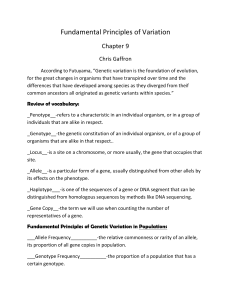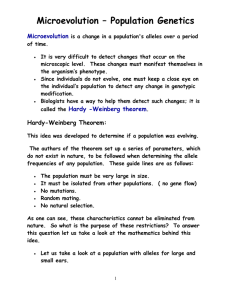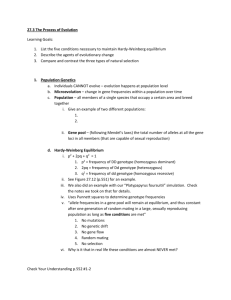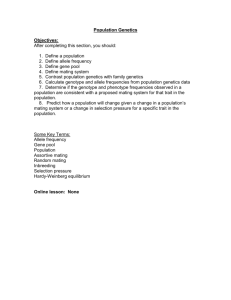LAB # 10 - POPULATION GENETICS
advertisement
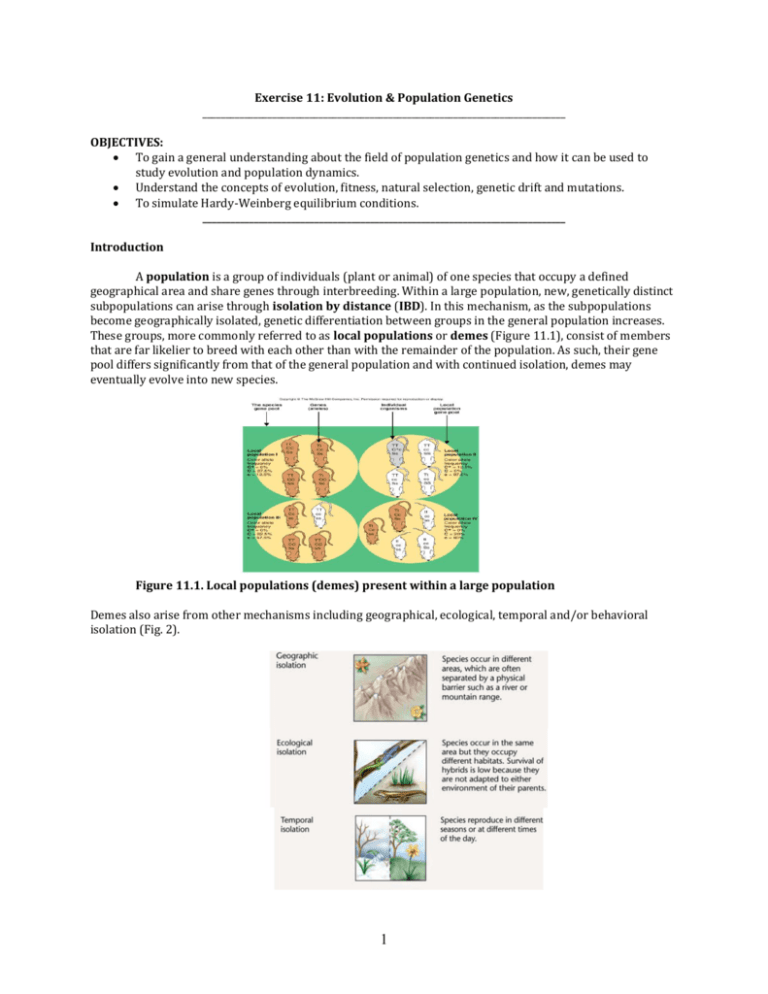
Exercise 11: Evolution & Population Genetics ______________________________________________________________________________ OBJECTIVES: To gain a general understanding about the field of population genetics and how it can be used to study evolution and population dynamics. Understand the concepts of evolution, fitness, natural selection, genetic drift and mutations. To simulate Hardy-Weinberg equilibrium conditions. ______________________________________________________________________________ Introduction A population is a group of individuals (plant or animal) of one species that occupy a defined geographical area and share genes through interbreeding. Within a large population, new, genetically distinct subpopulations can arise through isolation by distance (IBD). In this mechanism, as the subpopulations become geographically isolated, genetic differentiation between groups in the general population increases. These groups, more commonly referred to as local populations or demes (Figure 11.1), consist of members that are far likelier to breed with each other than with the remainder of the population. As such, their gene pool differs significantly from that of the general population and with continued isolation, demes may eventually evolve into new species. Figure 11.1. Local populations (demes) present within a large population Demes also arise from other mechanisms including geographical, ecological, temporal and/or behavioral isolation (Fig. 2). 1 Figure 11.2. Mechanisms of isolation Population genetics, which emerged as separate branch of genetics in the early 1900s, is a direct extension of Mendel’s laws of inheritance, Darwin’s ideas of natural selection, and the concepts of molecular genetics. The field of population genetics focuses on the population to which an individual belongs rather than on the individual. Within any given population, every individual has its own set of alleles; for diploid organisms, there are 2 alleles for each gene, one from the mother and one from the father. Collectively, every individual’s set of alleles comprises the population’s gene pool. The role of a population geneticist is to study the allelic and genotypic (Formulas 1 and 2, respectively) variation present within a population’s gene pool and to assess how this variation changes from one generation to the next. Example: In a population of 100 students, 64 are PTC tasters with genotype TT, 32 are PTC tasters with genotype Tt and the last 4 are non-tasters with genotype tt. a. What is the allelic frequency t? [ ( )] *2 (# of alleles in homozygous dominant condition) + 2 (# of alleles in heterozygous condition) + 2 (# of alleles in homozygous recessive condition) ( ( ) ) ( ) ( ) b. What is the genotypic frequency of tt? 2 ( ) In general, populations are dynamic units that change from one generation to the next. To be able to predict how a gene pool changes in response to fluctuations in size, geographic location and/or genetic composition, population geneticists have developed mathematical models that quantify these parameters. The most recognized of these is the Hardy-Weinberg (HW) equation, formulated by G. Hardy and W. Weinberg. ( ) This equation relates allele and genotype frequencies in a population and indicates the proportion of each allele combination that should exist within a population. In this formula, p2 = the frequency of a homozygous dominant genotype (e.g. BB) q2 = the frequency of a recessive genotype (e.g. bb) 2pq = the frequency of a heterozygote genotype (e.g. Bb) The HW equation predicts equilibrium, i.e., the allelic and genotypic frequencies remain constant over the course of many generations, if the following five assumptions are met: (1) Large population size, (2) Random mating, (3) No mutation, (4) No migration, (5) No natural selection. In reality, no population ever satisfies HW equilibrium completely. Example 1: If in a population of 100 cats, 84 carry a dominant allele for black coat (B) and 16 carry the recessive allele for white coat (b), then the frequency of the black phenotype is 0.84 and of the white phenotype is 0.16. a. Using the HW equation, calculate the frequencies of alleles B and b. frequency of white (bb) cats = 16/100 = 0.16 q2 = 0.16 therefore q = √ b. = 0.4 since p + q =1, then p = 1 – q therefore, p =1- 0.4 = 0.6 Using the HW equation, calculate the frequencies of the BB and Bb genotypes. From part a, we know that p = 0.6 and q = 0.4 therefore, the frequency of BB cats is p2 = (0.6)2 = 0.36 and the frequency of Bb cats = 2pq = 2(0.6)(0.4) = 0.48 3 Fig. 11.10 Figure 11.3 Hardy-Weinberg Equilibrium Example To check: since p2 + 2pq + q2 = 1, then 0.36 + 0.48 +0.16 = 1 Example 2: In a population of fruit flies, the genotypes of individuals present are: 50 RR, 20 Rr and 30 rr where R = red eyes and r = white eyes. Assuming the population is in Hardy-Weinberg equilibrium, the proportion of each genotype would be determined as follows: a. Using Formula 1, calculate the frequency of each allele, in this case R and r. ( ( ) ) ( ) ( ) Therefore, q, the frequency of the recessive allele, equals 0.4. b. Since q is known, the p+q = 1 is equation is used to determine p, the frequency of the dominant allele. since p + q =1, then p = 1 – q therefore, p = 1 – 0.4 = 0.6 c. Now using the HW equation, we can calculate the proportion of RR, Rr and rr individuals in the population. From part a and b, we know that p = 0.6 and q = 0.4 therefore, the frequency of RR individuals is p2 = (0.6)2 = 0.36 the frequency of those with the Rr genotype = 2pq = 2(0.6)(0.4) = 0.48 and the frequency of rr flies = q2 = (0.4)2 = 0.16 d. Since there are 100 flies in our population, when the population is in HW equilibirium, 36 flies are homozygous dominant (RR), 48 are heterozygous (Rr) and the remaining16 are homozygous recessive (rr). 4 The genetic composition of a population’s gene pool can be affected by several evolutionary factors, including mutations, migration, non-random mating, genetic drift and natural selection. Mutations, changes in the DNA sequence, are the ultimate source of genetic variation in a population’s gene pool but because mutation rates are generally low, mutations alone do not usually result in changes in allele frequency. Allelic distributions in a particular group can also fluctuate due to migration, i.e. the movement of individuals either into (immigration) or out of (emigration) a population, resulting in either the addition or loss of alleles, respectively. Diversity within a population is also affected by random events, a process referred to as genetic drift. Two examples of genetic drift are (1) founder effects (Fig. 3A) and (2) genetic bottlenecks (Fig. 3B). In the first scenario, a small group of individuals leave the original population and start a new population in a different location. In contrast, a bottleneck occurs when the original population is drastically reduced in size as a result of some type of natural disaster (e.g. fires, hurricanes, disease, etc.). In addition, non-random mating (e.g. inbreeding/self-fertilization – increases homozygosity) and natural selection (survival of the fittest) also alter the genetic variation within a population. A. B. Figure 4. A. Founder effect and B. Bottleneck effect In summary, the various techniques employed by population geneticists enable them to determine the frequency of gene interaction (gene flow) among different populations and examine the effects of natural selection, migration and mutations, on the genetic composition of these groups. Overall, population genetics attempts to explain how adaptation and speciation shape biological populations over time. In today’s lab you will use the concepts and techniques of population genetics to answer questions about the genetic composition of particular populations. Learning how gene flow occurs within and between populations can provide valuable insight about the processes that lead to genetic variation and ultimately speciation (i.e. evolution of new species). Task 2- Pepper Moth: Industrial Melanism Charles Darwin accumulated a tremendous collection of facts to support the theory of evolution by natural selection. One of his difficulties in demonstrating the theory, however, was the lack of an example of evolution over a short period of time, which could be observed as it was taking place in nature. Although Darwin was unaware of it, remarkable examples of evolution, which might have helped to persuade people of his theory, were in the countryside of his native England. One such example is the evolution of the peppered moth Biston betularia. The economic changes known as the industrial revolution began in the middle of the eighteenth century. Since then, tons of soot have been deposited on the country side around industrial areas. The soot discolored and generally darkened the surfaces of trees and rocks. In 1848, a dark-colored moth was first recorded. Today, in some areas, 90% or more of the peppered moths are dark in color. More than 70 species of moth in England have undergone a change from light to dark. Similar observations have been made in other industrial nations, including the United States. Industrial melanism is a term used to describe the adaptation of a population in response to pollution. One example of rapid industrial melanism occurred in populations of peppered moths in the area of Manchester, 5 England from 1845 to 1890. Before the industrial revolution, the trunks of the trees in the forest around Manchester were light due to the presence of lichens. Most of the peppered moths in the area were light colored with dark spots. As the industrial revolution progressed, the tree trunks became covered with soot and turned dark. Over a period of 45 years, the dark variety of the peppered moth became more common. In general, birds in the area hunted the moths for food. The camouflage of the moths plays an important role in determining whether the birds could see and hunt their prey Procedure 1. 2. Choose one person in the group to be the “bird predator”. Place a sheet of white paper on the table and have one person spread 30 white circles and 30 newspaper cutouts over the surface while the “predator” isn't looking. The "predator" will then pick up as many of the circles as he can in 15 seconds. Record your results in the data table under Trial 1. Repeat steps 2 – 3 again. Record your results in the data table under Trial 2. Place a sheet of newspaper on the table and have one person spread 30 white cutouts and 30 newspaper cutouts over the surface while the “predator” isn't looking. The "predator" will then pick up as many of the circles as he can in 15 seconds. Record your results in the data table under Trial 3. Repeat steps 6 – 7 again. Record your results in the data table under Trial 4. 3. 4. 5. 6. 7. 8. 9. Based on what you know about the pepper moth, formulate hypotheses (Scientific, Ho and Ha) for what you expect to occur to the population numbers of the peppered moth. Write both hypotheses in the space provided and explain your reasoning for each. Scientific: Ho: Ha: Make Predictions: For each trial write down whether you expect the resulting number of white or dark peppered moths to have a larger population size or smaller population size than the other population. Table 11.1: Trials 1 2 3 4 Population sizes (larger/smaller) Results Table 11.2. Group Results Trial Background 1 white 2 white 3 newspaper 4 newspaper Starting Population Dark moths 6 White moths Number Picked up White moths Dark moths Table 11.3. Class Results Trial Background 1 white 2 white 3 newspaper 4 newspaper Starting Population Dark moths White moths Number Picked up White moths Dark moths Graph the class results using Excel. In the space below describe the trends seen on your graph. Questions: 1. Which of the variables is (are) the independent variable(s)? 2. Which of the variables is (are) the dependent variable(s)? 3. What variables serve as controls and what do they control for? 4. Did your observed results reflect your predictions. Explain. 5. What did the experiment show about how prey are selected by predators? 6. Which colored moths are best adapted to an unpolluted environment? Use your results to support your answer. 7. Which colored moths are best adapted to a polluted environment? Use your results to support your answer. 8. What would you expect the next generation of moths to look like after Trial 1? Why do you think this? 7 9. What would you expect the next generation of moths to look like after Trial 3? Why do you think this? 10. What is natural selection? How your experiment show that natural selection occurred in the moth populations? Use your results to support your answer. 11. Do you reject or fail to reject your null hypothesis? Explain. TASK 3 - Genotypic Frequencies and Hardy Weinberg (HW) Equilibrium You can use the HW equations and your knowledge about allelic and genotypic frequencies to address many population genetics questions. The four problems below provide excellent examples. Questions: 12. State the Hardy-Weinberg Equilibrium Equation and identify what each value in the equation means. Problem 1: Gene and Genotype Frequencies In addition to the ABO antigens, several other classes of glycoproteins are present on the surface of red blood cells. Examples include the MN, Rh, Duffy and Lewis antigens. For this exercise, we will focus on the MN blood protein system. The MN antigens, like the ABO blood proteins, display codominant inheritance where both alleles (i.e., M and N) are expressed simultaneously. You are a member of a group of 100 students who have accidentally been locked in the gym overnight. To amuse yourselves, rather than playing “spin the bottle”, “beer pong” or “truth-or-dare”, you decide to calculate the frequencies of MN alleles amongst yourselves. Miraculously, everyone present knows his/her genotype. You learn that 49 people are MM, 42 people are MN, and 9 people are NN. If, M = p and N = q, answer the questions that follow, making sure to show all calculations: 13. How many M alleles are present among the group? 14. How many N alleles are present among the group? 15. What is the frequency of the M allele? 8 16. What is the frequency of the N allele? 17. What are the frequencies of MM, MN and NN genotypes? Problem 2: Gene Frequencies in a Medical Application The island of Madagascar has a total population of 1300 people, including 13 individuals who are afflicted by Cystic Fibrosis (CF), a recessively inherited disease. Researchers are interested in knowing how many people in the Madagascar populace are carriers of CF, and have requested your assistance as the resident physical anthropologist. If the C allele is dominant and the c allele is recessive, answer the questions that follow. (Show all calculations) 18. What is the frequency of recessive individuals in the Madagascar populace? 19. What is the frequency of dominant individuals in this population? 20. What is the frequency of the Cc genotype in Madagascar? 21. How many people in this population are normal (i.e. not carriers)? 22. How many people in this population are carriers? 9 Problem 3: Examine Your Own Traits Using yourself and your lab mates, complete Tables 11.4, 11.5 and 11.6. Table 11.4: Individual Observations Trait Allele Inheritance Your Phenotype Your possible Character Pattern (check one) genotype DOM Widow’s Peak W dominant Attached Earlobes a recessive Darwin’s Ear Point E dominant Cleft Chin c recessive Unpigmente d Iris (blue) b recessive 10 REC Trait Allele Inheritance Character Pattern Tongue Rolling R dominant Tongue Folding f recessive Hitchhiker’s Thumb h recessive Freckles L dominant Mid-Digital Hair M dominant Dimples D dominant PTC tasting T dominant DOM = dominant, REC = recessive 11 DOM REC Possible Genotype Table 11.5: Observations for Your Class Trait Total Number Number of Dominant Phenotypes % of Total Number of Recessive Phenotypes 1. Widow’s Peak 2. Attached Earlobes 3. Darwin’s Ear Point 4. Cleft Chin 5. Unpigmented Iris 6. Tongue Rolling 7. Tongue Folding 8. Hitchhiker’s Thumb 9. Freckles 10. Mid-Digital Hair 11. Dimples 12. PTC tasting Table 11.6: Expected Allele and Genotype Frequencies* for Your Class Trait Allele Frequencies Genotype Frequencies p q p2 2pq q2 1. Widow’s Peak 2. Attached Earlobes 3. Darwin’s Ear Point 4. Cleft Chin 5. Unpigmented Iris 6. Tongue Rolling 7. Tongue Folding 8. Hitchhiker’s Thumb 9. Freckles 10. Mid-Digital Hair 11. Dimples 12. PTC tasting *Note: these are the expected genotypic frequencies if the population is in HW equilibrium. 12 % of Total Task 4- Mutations In nature, mutation is the process that creates new alleles. Mutations are mistakes that happen during DNA replication before cell division, or abnormalities that develop in chromosomes during cell division. Whatever the source, mutations contribute to genetic variability in populations. However, their effect is usually much less than that of genetic recombination that occurs as a result of crossing over. Mutations can be neutral, having no effect, or be detrimental or even beneficial. Usually, but not always, mutations create recessive alleles. This means that the trait would not be expressed until it appeared in a homozygous individual, a process that could take several generations. Natural selection is the agent in nature that determines whether a mutation is “good” or “bad.” A detrimental mutation (allele) would be selected against; for example, organisms with the mutation would not function as well in the environment and would leave fewer offspring. Over time, the frequency of genotypes carrying a detrimental mutation should decrease in the population. The opposite would be true for a beneficial mutation. In this task, you will experimentally induce mutations in a two bacteria, Escherichia coli and Serratia marcescens. Bacteria are good organisms to use in mutation studies because they are haploid. If a mutation occurs, it is expressed because there is not a second allele present to mask it. You will study mutations affecting viability in these two bacteria. Such mutations are called lethal mutations because the mutant gene fails to produce a needed product and the cell dies. Mutations can be induced by several means. Chemicals, called mutagens can change an organism’s DNA, causing changes in hereditary information. Ultraviolet radiation has similar effects and will be used in the experiment, Because mutations caused by UV exposures are random, many different mutations will be induced in the bacteria. Some may affect pigment synthesis in Serratia. This bacterium is normally red, but when a mutation occurs in the genes producing the enzymes involved in pigment synthesis, no pigment is made and the bacteria are white. Other mutations will kill the bacteria because the UV exposure damages genes that are essential to life. Based on what you know about UV exposure, formulate hypotheses (Scientific ,Ho and Ha) for what you expect to occur to the number of colonies at the different exposure times. Write the hypotheses in the space provided and explain your reasoning for each. Scientific: Ho: Ha: Based on what you know about UV exposure, formulate hypotheses (Scientific, Ho and Ha) for what you expect to occur to the number of Serratia marcescens colonies in comparison to the number of Escherichia coli colonies. Write the hypotheses in the space provided and explain your reasoning for each. Scientific: Ho: Ha: 13 Make Predictions: For each trial write down whether you expect the resulting bacterial populations to have a larger amount of colonies or smaller amount of colonies than the other bacterial population. Table 11.7. Predictions Exposure Time 0 seconds 10 seconds 30 seconds 1 minute 2 minutes 3 minutes 5 minutes Serratia marcescens Escherichia coli Procedure: 1. 2. 3. 4. 5. 6. 7. 8. 9. Using a plastic sterile loop pick up a very small amount of E. coli and place the bacteria into a test tube with 10 mL of LB nutrient broth. Allow the bacteria about 10 minutes to acclimate. Make sure that the bacteria is evenly distributed in the broth before performing the next step. Add 0.1mL of the culture to 9.9mL of LB Broth. Take 0.1mL of the dilution culture and add it to 9.9mL of LB Broth in the final test tube. Plate the volumes of bacteria according to Table 11.8. Repeat the steps for S. marcescens. Spread the bacteria on the plates using proper aseptic techniques. Expose the bacterial plates to UV light. Make sure the plates are dry before placing them open and upside down on the UV light box. WIPE DOWN THE BOX ONCE THE EXPERIMENT IS OVER. Follow the results tables to record your final results Table 11.8. Exposure and Volumes Exposure Time 0 seconds 10 seconds 30 seconds 1 minute 2 minutes 3 minutes 5 minutes Sample Volume (µL) 10 20 20 40 40 40 80 Questions: 1. Which of the variables is (are) the independent variable(s)? 2. Which of the variables is (are) the dependent variable(s)? 3. What variables serve as controls and what do they control for? 14 Results: Table 11.9. Escherichia coli Plate Sample Vol. 1 2 3 4 5 6 7 25 50 50 100 100 100 200 Cumulative UV exposure (seconds) 0 10 30 60 120 180 300 Table 11.10. Serratia marcescens Cumulative Plate Sample Vol. UV exposure (seconds) 1 25 0 2 50 10 3 50 30 4 100 60 5 100 120 6 100 180 7 200 300 Total No. Colonies Colony adjustment factor X4 X2 X2 Corrected No. Colonies % surviving Corrected No. Colonies % surviving X0.5 Total No. Colonies Colony adjustment factor X4 X2 X2 X0.5 When you examine the plates, count the total number of colonies on each plate receiving short UV exposures received lesser volumes of the cell suspension, and the numbers should be corrected by multiplying the colony counts times a volume correction factor. This calculation makes all counts for all plates directly comparable. Record the corrected number of colonies for each treatment. Calculate the percent surviving by dividing total colony count from plate #1 into colony counts for all other plates and multiplying by 100. Plot the percent surviving (from total counts) as a function of irradiation time. 23. Did your observed results reflect your predictions over time? Explain. 24. Did your observed results reflect your predictions between the two bacteria? Explain. 25. Why is UV radiation effective in destroying most types of microorganisms 15 TASK 5 - Random Mating, Natural Selection, Migration, Bottlenecking and Mutation This task will allow you to further examine the HW equilibrium model utilizing a set of cards representing alleles (A, a, and later on, α) and a number of given “events” that may affect the “gene pool.” Half of the cards in the population have a lower case a on them and the other half have an upper case A. Distribute two cards to each student, with ¼ of the students receiving AA, ½ receiving Aa and the last ¼ receiving aa. In this task, each student will represent an insect that is part of a general population (i.e., the class) of insects. This particular insect species mates (randomly) once a year and then dies. Note that each year the number of offspring produced is the same as that of the previous year. Note and record your genotype here: _______________ Part 1: Random Mating 1. 2. To simulate a random mating event, all students should now place their cards back into the “gene pool.” Make sure to shake the “gene pool” occasionally to ensure randomness. Each student should pick two cards from the “gene pool.” The new allelic pairs chosen represent the second generation. Record the number and ratio of allelic pairs present in the new generation in Table 11.11. Table 11.11: Genotype Number Ratio AA Aa aa Total Questions: a. Is the ratio of genotypes from the second generation different from those in initial population? b. Were either the first or second generations in Hardy Weinberg equilibrium? Why or why not? c. What are the frequencies for the two alleles in each generation? Did they change? Why or why not? d. What should happen if we create a third generation now, exactly as we did before? Would you expect changes to occur? Why or why not? 16 Part 2: Natural Selection 1. 2. 3. 4. 5. Each individual should exchange cards so that everyone returns to their initial genotype. For this exercise, insects bearing the aa genotype are unable to get food and are highly susceptible to disease. As a result, half of the aa individuals are unable to mate. Your instructor will randomly select which of the aa individuals will not participate in mating and will instruct them to move away from the rest of the group. All other individuals should place their cards back into the “gene pool” to represent random mating. Following the mating event, each student should pick two cards from the “gene pool.” Record the number and ratio of allelic pairs present in the new population in Table 11.12. How do you expect each of the genotypic frequencies to change as a result of this mating event? Table 11.12: Genotype Number Ratio AA Aa aa Total Questions: a. Did the ratios change from the parental population? Why or why not? b. Did the number of alleles change? Why? c. What would you expect to see over time, if this scenario keeps occurring to those with aa? Part 3: Migration and Founder Effect 1. 2. 3. 4. The individuals cast out of the breeding population in part 2 need to re-join the general population for this exercise. All individuals should exchange cards so that everyone has the initial pair that he/she started with at the beginning of this task. For this exercise, your instructor will choose every third individual to join a subgroup of the population that is going to migrate to a new location. These individuals should move to another section of the classroom to form a “New” population. The remaining individuals, who form the “Homeland” population, should mate by placing their cards into the “gene pool.” The migrated population should also mate by placing their cards into their own “gene pool” 17 5. 6. After mating, each individual (in both populations) should choose two cards from their respective “gene pool.” Record the number and ratio of allelic pairs present in the new generation for both the “Homeland” and “New” populations in Tables 11.13 and 11.14, respectively. How do you expect each of the genotypic frequencies of the “Homeland” and “New” populations to change as a result of this mating event? What do you expect to happen to genetic diversity in the “New” population? Table 11.13: “Homeland” Genotype Number Ratio Number Ratio AA Aa aa Total Table 11.14: “New” Genotype AA Aa aa Total Questions: a. Does the ratio of genotypes differ between these most recent generations and the initial parental generation? Why? b. What about the allele frequencies? Why? 18 Part 4: Mutation 1. 2. 3. 4. 5. 6. All individuals should exchange cards so that they have the initial pair that they started with at the beginning of the task. Your instructor will randomly choose three A individuals to undergo a mutation event of an a allele. These individuals should exchange cards with their instructor to represent this change. In addition, your instructor will also randomly choose three other individuals with an A allele to mutate of an α allele. These individuals should exchange cards with their instructor to represent this mutation event. All cards should be placed into the “gene pool” to simulate random mating. At this point, each individual should pick two cards from the “gene pool”. Record the number and ratio of allelic pairs present in the new generation in Table 11.15. How do you expect the mutations to affect the resulting population? Explain. Table 11.15: Genotype Number Ratio AA Aa aa Aα aα αα Totals Questions: a. Did the ratio of genotypes change from the initial parental population? If so, why do you think this occurred? b. What about allelic frequencies? Why did this occur? 19






